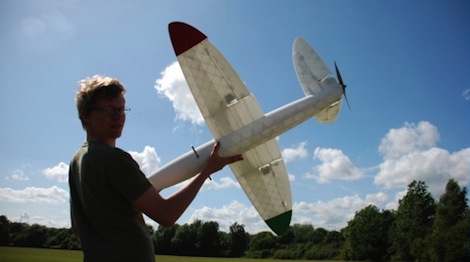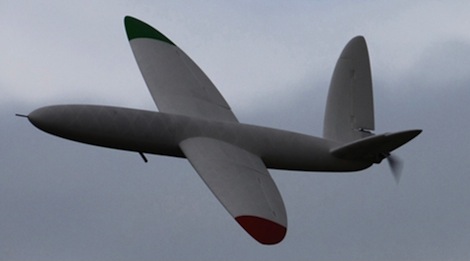
It seems that the academic world has been going UAV crazy for the last year. There have been two recent projects covered online that are fascinating for those of us with even the most passing interest in things that fly, things that are directly manufactured and things that don’t require pilots. And yes, even those of us that have seen Eagle Eye and fear a Reaper Drone ascending on us in the streets of New York are still going to love it (and frankly, it’s better that than having to watch another Shia LaBeouf movie).
The Southampton University Laser Sintered Aircraft (SULSA)
First up the work done at Southampton University by Professors Keane and Scanlan who worked in partnership with direct manufacturing wizards 3T to produce ‘the world’s first 3D-printed plane’: The Southampton University Laser Sintered Aircraft (SULSA). And it has already successfully taken flight.

The brief from the Professors included that the aircraft had to be lightweight and strong, as it would be built in just four parts – the main fuselage and rudder fins, the nose cone and two outer wings. They were looking for a process that could integrate multiple design features to make the assembly of the model quick and easy, without the need for time-consuming post-processing. The aircraft fuselage and wings housed a number of internal mechanical components and they required a simple method of fitting them.
The SULSA team took advantage of the benefits offered by plastic Additive Manufacturing (AM) and used the nylon SLS (Selective Laser Sintering) services of 3T. The four parts of the plane simply clipped together to form an Unmanned Air Vehicle (UAV) with a 1.2 metre wingspan.
Designed in SolidWorks, the SULSA team passed the data to 3T’s team of CAD Engineers who incorporated the snap fittings required to hold the four nylon parts together to form the overall aircraft. They also designed mountings and channels to hold the ten internal components, enabling the motor, battery, avionics and controls to be clipped into place inside the main fuselage, and two servos, one in each wing. The wings had two ailerons moulded in with hinges and there were similar large hinged flaps on the rear control surfaces. All these features were incorporated into the aircraft’s design and the ability of SLS to create hinge features and clips meant that they were built as integral parts to the main components, thereby increasing their functionality and reducing the need for additional parts to be fitted post-build. No screws or other mechanical fasteners were used in the design at all.
Jim Scanlan, Professor of Aerospace Design at University of Southampton, says “The entire structure of the aircraft has been printed including wings, integral control surfaces and access hatches. Thanks to 3T’s CAD Engineers, no fasteners were used and all equipment was attached using ‘snap fit’ techniques such that the entire aircraft can be put together without tools in minutes.”
The flexibility of the laser sintering process allowed the SULSA design team to re-visit historical techniques and ideas that would have been prohibitively expensive using conventional manufacturing. One of these ideas involved the use of a Geodetic structure. This type of structure was initially developed by Barnes Wallace and famously used on the Vickers Wellington bomber which first flew in 1936. This form of structure is very stiff and lightweight, but very complex. If it was manufactured conventionally it would require a large number of individually tailored parts that would have to be bonded or fastened at great expense. Hence, SLS offered the ideal solution for this project.
Scanlan adds “Another design idea that laser sintering facilitates is the use of an elliptical wing planform. Aerodynamicists have, for decades, known that elliptical wings offer drag benefits. Heinkel produced the He 70 aircraft in the early 1930’s which exploited such a wing. More famously, Mitchell’s aerodynamicist Beverley Shenstone selected this shape for the Spitfire aircraft of the late 1930’s. The Spitfire wing was recognised as an extremely efficient design but it was notoriously difficult and expensive to manufacture. A direct contemporary of the Spitfire, the German Messerschmitt 109, used a tapered wing that was slightly less aerodynamic but roughly half the manufacturing cost of the Spitfire wing. Again, laser sintering removes the manufacturing constraint associated with shape complexity and in the SULSA aircraft there is no cost penalty in using an elliptical shape.”
How long did it take? Stuart Offer, SLS Sales Manager at 3T said that “This project took little more than a month to complete with initial design drawings being submitted to us in early May 2011, and the UAV making its first flight on 8tth June 2011. With simplified assembly due to the internal design features, SLS was the ideal solution as it also offered tremendous strength despite the weight of the plastic parts being less than 2kg. The ability to produce complex yet lightweight components contributed immensely to the success of this project.”
If you want to see it in action and how it was made, there’s a nifty video from the New Scientist folks:
Middlesex University SQ-4

There’s also another story doing the rounds from the folks at themanufacturer.com about how “Robotics experts at Middlesex University have developed a lightweight outdoor flying video camera” that looks all kinds of amazing – and judging by the casing, probably 3D printed too (I’d guess an FDM by the layering markings in the photos).
Update: just been sent the press release, so I can add a few more details.
The device is designed to fit in a soldiers backpack and help spot hidden dangers and feed the real-time footage to goggles worn by the operator. Unlike currently available equipment, the flying camera – nicknamed SQ-4 – is around the diameter of a Frisbee, weighs a mere 230 grams and is operational in less than a minute. SQ-4 reaches heights of up to 400 ft and can quietly hover or even perch on objects as it zooms in on suspicious activity or devices. Its miniature cameras also have a night lens for surveillance operations in the dark.
Currently, similar systems used in Afghanistan are much more expensive, resulting in fewer being deployed. As SQ-4 is a fraction of their cost, many more soldiers could be equipped with them. Existing systems are also usually larger, heavier and have fixed wings meaning that they are unable to hover above targets and are more likely to be detected and targeted. The SQ-4 is controlled by a handheld remote control and goggles which provide the wearer with information like the latitude and longitude of the vehicle, the distance between the location and the home point and the direction to home point, ensuring the soldier remains orientated at all times. The intelligent system also allows SQ-4 to autonomously fly from its last position to its launch point.
The team who created SQ-4 is led by Middlesex robotics expert Dr Stephen Prior and is made up of students Mehmet Ali Erbil, Mantas Brazinskas and Witek Mielniczek. They created the SQ-4 in partnership with Cardiff-based BCB International, which makes survival and protective equipment. Middlesex University robotics specialist Dr Stephen Prior: “It’s vital that soldiers surveillance work goes unnoticed and SQ-4 is far smaller than current devices which look very much like large model aircraft and are over a metre in size. We’re providing a bird’s eye view with a vehicle that’s literally the size of a bird.”
25-year old Middlesex University PhD student Mehmet Ali Erbil said: “This could make solders even more effective at scanning areas for bombs, traps or suspicious activity as current systems are cumbersome and costly so their use is more limited. SQ-4 could give British troops the competitive edge and reduce their vulnerability in unfamiliar terrains.”
The SQ-4 together with another UAV the team have developed called the HALO will be unveiled at the world’s largest defence and security exhibition, ‘Defence & Security Equipment International 2011’ (DSEi), at the ExCel London from 13-16 September, where it will be viewed by tens of thousands of visitors and military personnel from across the globe. The team are hoping to impress the military and security services at the exhibition where they will be demonstrating its surveillance capabilities in a model of Afghanistan.
You can see it in action in this, rather annoyingly difficult to share video – http://www.play.mdx.ac.uk/videos/iayo






